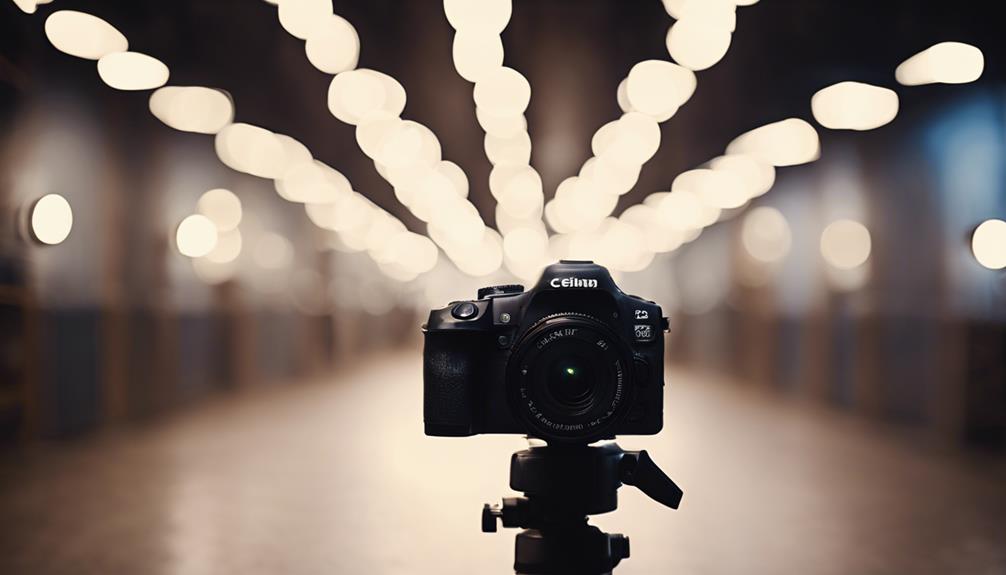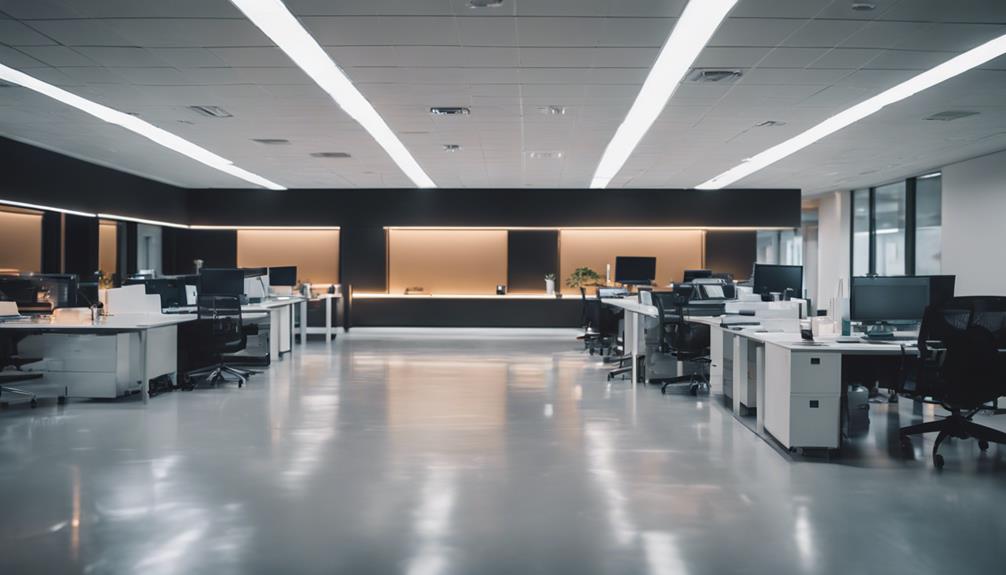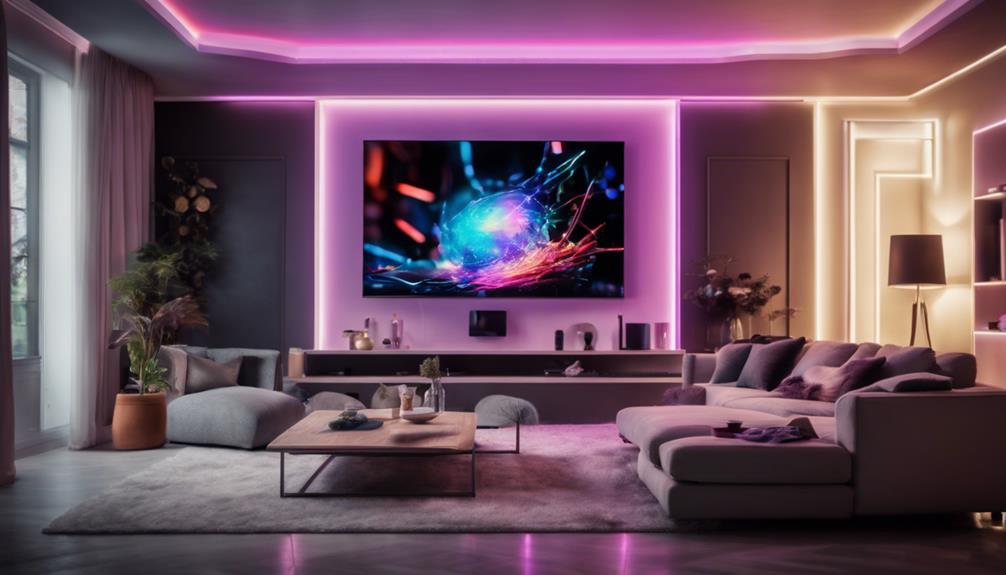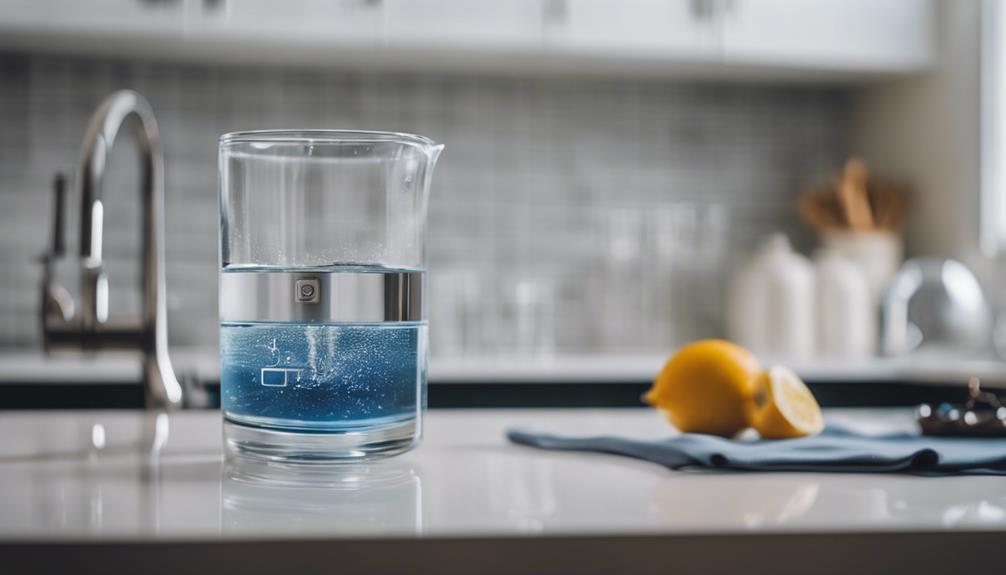LED lighting is the dominant choice for illumination for ten key reasons. First and foremost, it excels in energy efficiency, saving up to 80% compared to traditional options, with minimal heat waste. Additionally, its long lifespan of up to 20 years reduces replacements and waste. In terms of cost, LED lighting significantly reduces energy bills and maintenance expenses. The quality of light it emits is excellent with precise color accuracy. Furthermore, it is environmentally friendly, sustainable, and versatile for various applications. Enhanced safety features like reduced fire risk and minimal heat make LED lighting a smart choice. Discover more reasons why LED lighting is the superior option for illumination.
Key Takeaways
- LED lighting saves up to 80% energy compared to traditional options
- Long lifespan of up to 20 years reduces replacements and waste
- Cost-effective with up to 80% energy cost savings
- Improved light quality with high CRI and customizable options
- Environmentally friendly, decreasing CO2 emissions and promoting sustainability
Energy Efficiency
LED lighting guarantees exceptional energy efficiency compared to traditional lighting options, with savings of up to 80%. This efficiency is primarily due to the way LEDs convert 95% of the energy they consume into light, minimizing wasted energy in the form of heat. When compared to incandescent bulbs, LED bulbs use about 75% less energy on average, making them a much more sustainable lighting choice.
The energy savings derived from using LED lighting can result in significant cost reductions over time. Businesses and households alike can benefit from lower energy bills by making the switch to LED technology. Additionally, as LED technology continues to advance, so does its energy efficiency and sustainability. This continual improvement ensures that LED lighting remains at the forefront of energy-efficient lighting solutions, offering not only cost savings but also environmental benefits.
Long Lifespan

With LED lighting's exceptional energy efficiency established, the discussion now shifts to the impressive longevity of these lights in the subtopic of Long Lifespan. LED lights are renowned for their long lifespan, offering various benefits that contribute to their widespread adoption in homes and businesses.
- Extended Lifespan: LED lights can last up to 20 years with 10 hours of daily use, surpassing traditional bulbs by a significant margin.
- Reduced Waste: The durable nature of LED lights reduces waste production and the frequency of replacements, making them a sustainable lighting option.
- Energy Efficiency: LED lights not only provide bright illumination but also promote energy savings due to their efficiency and longevity.
LED lights not only outshine traditional lighting options in terms of brightness but also excel in durability and sustainability. These qualities make LED lights a superior choice for those looking to save on energy costs while enjoying long-lasting and efficient lighting solutions.
Cost Savings

Realizing substantial savings is a key advantage of adopting LED lighting, particularly with regards to cost efficiency. LED lighting can lead to impressive cost savings, with the potential to reduce energy costs by up to 80% when compared to traditional lighting sources.
The longevity of LED bulbs is another significant factor contributing to cost-effectiveness, as it diminishes the need for frequent replacements and maintenance, thereby reducing overall expenses. Studies have shown that businesses and homes can save hundreds to thousands of dollars annually by switching to LED lighting due to its energy efficiency and long lifespan of 25,000 to 50,000 hours.
In commercial settings, the impact is even more pronounced, with substantial reductions in electricity usage translating to lower utility bills. These cost savings make LED lighting a smart investment for those looking to improve cost efficiency and reduce maintenance costs over the long term.
Improved Light Quality

LED lighting presents superior light quality through high CRI values, enhancing color accuracy and object visibility.
Its directional feature reduces glare and light spillage, providing focused illumination for enhanced visual comfort.
Additionally, the customizable color temperatures and dimmable options allow users to create the desired ambiance and adapt to various lighting needs.
Brighter Illumination Control
Amplifying the quality of illumination, LEDs provide precise control over brightness levels to enhance visibility in various settings. This enhanced light quality is achieved through tailored illumination, which reduces glare and improves color rendering for a clearer and more comfortable visual experience.
The dimmable capabilities of LEDs further contribute to this by allowing users to adjust the light intensity according to their preferences, creating the desired atmosphere for different activities. With advanced LED technology, customizable lighting designs can be implemented to meet specific requirements, ensuring ideal brightness levels that are consistent and uniform across different spaces.
This level of control not only enhances visual comfort and productivity but also adds a touch of personalization to lighting solutions.
Energy-Efficient Lighting Solutions
By dramatically reducing electricity consumption, energy-efficient LED lighting solutions not only offer cost savings but also enhance light quality with improved visibility and aesthetics. LED lighting is up to 80% more energy-efficient than traditional lighting sources, lowering electricity usage to a great extent.
The technology provides superior light quality with a high color rendering index (CRI), improving visibility and aesthetics in various settings. LEDs deliver instant full brightness without warm-up time, enhancing productivity and safety.
These energy-efficient solutions not only contribute to cost savings but also promote environmental sustainability by reducing the carbon footprint. Additionally, the enhanced light quality of LEDs enhances visual comfort, reducing eye strain and fostering a healthier lighting environment.
Long-Lasting LED Bulbs
With its exceptional longevity and enhanced illumination quality, long-lasting LED bulbs offer a reliable and cost-effective lighting solution for various applications. LED bulbs can last up to 60,000 hours, surpassing traditional bulbs by a considerable margin.
The improved light quality guarantees instant full brightness without flickering or warm-up time, enhancing the ambiance of interior spaces. Additionally, LEDs in interior fixtures provide superior durability and performance, making them a cost-effective choice for long-term use.
These bulbs not only reduce electricity consumption significantly, leading to lower energy bills, but also require less maintenance over time. Overall, the long-lasting nature of LED bulbs makes them a practical and efficient lighting option for both residential and commercial settings.
Instant Full Brightness

LED lighting instantly illuminates to full brightness upon activation, providing immediate visibility and efficiency in various environments. Unlike traditional bulbs that require time to warm up, LED lights deliver their maximum light output instantly. This feature enhances productivity by eliminating delays in achieving full brightness, making them ideal for security lighting and task-oriented spaces.
The quick response of LEDs guarantees that areas needing immediate lighting have instant illumination, improving safety and functionality. Whether in emergency situations or daily tasks, the instant full brightness of LED lighting offers consistent and reliable performance. By offering instant visibility, LED lights contribute to a more productive and secure environment.
Their immediate brightness capability sets them apart from traditional lighting options, offering a practical solution for areas where quick and efficient lighting is essential.
Minimal Maintenance

The prolonged lifespan of LED lighting greatly reduces maintenance requirements, resulting in cost and time savings. LED lights can last up to 50,000 hours, much longer than traditional lighting options.
Here are three key points highlighting the minimal maintenance benefits of LED lighting:
- Cost Savings: With reduced replacement frequency, businesses and homeowners save on maintenance costs associated with labor and new fixtures.
- Operational Efficiency: LED technology's reliability guarantees consistent performance over an extended period, minimizing maintenance interruptions and enhancing operational efficiency.
- Durability: The durability of LED fixtures means they require fewer repairs and replacements, further reducing maintenance needs and associated costs.
Environmentally Friendly

LED lighting is hailed as an environmentally friendly option due to its remarkable energy efficiency. By consuming up to 90% less energy than incandescent bulbs, LEDs help reduce carbon footprints to a large extent.
This sustainable choice not only lowers electricity consumption but also promotes eco-friendliness through its long lifespan and absence of toxic materials.
Energy-Efficient Lighting Solution
Switching to energy-efficient lighting solutions can lead to significant reductions in energy consumption and contribute to a more environmentally friendly approach to lighting. LED lighting, known for its energy efficiency, offers a longer lifespan compared to traditional incandescent bulbs. Here are three key benefits of energy-efficient LED lighting:
- Lower Energy Consumption: LED lighting is up to 80% more energy-efficient than traditional lighting sources, resulting in reduced electricity bills and lower energy usage.
- Longer Lifespan: LEDs can last up to 25 times longer than incandescent bulbs, reducing the frequency of replacements and minimizing waste.
- Environmentally Friendly Practices: The energy efficiency of LEDs helps in reducing carbon emissions, promoting sustainability, and contributing to a greener environment.
Reduced Carbon Footprint
Energy-efficient LED lighting significantly reduces carbon footprint by consuming less energy and emitting lower greenhouse gases compared to traditional lighting sources. LED technology contributes to environmental sustainability by decreasing CO2 emissions and promoting energy efficiency.
By minimizing electricity consumption, LED lights play an important role in combating climate change and supporting eco-friendly practices. The adoption of LED lighting not only lowers energy demand but also fosters a greener future through its sustainable design and efficient operation.
This shift to LED technology helps reduce environmental harm and aligns with the global push for more sustainable and energy-efficient lighting solutions.
Sustainable and Eco-Friendly
With its reduced heat emissions and lower greenhouse gas output, LED lighting stands out as an environmentally friendly choice for sustainable illumination. LED lights offer a range of benefits that contribute to their eco-friendly nature:
- LEDs have a long lifespan, reducing the frequency of replacements and minimizing waste.
- Energy-efficient LED technology consumes less electricity, promoting sustainability and reducing environmental impact.
- LED lights are mercury-free, making them a safe and eco-conscious lighting choice.
The recyclability of LED materials further enhances their sustainability, providing a more environmentally friendly lighting solution compared to traditional alternatives. LED lighting not only benefits consumers but also the planet, making it a preferred choice for those looking to reduce their environmental footprint.
Versatile Applications

In various indoor and outdoor settings, LEDs display their versatility by catering to a wide range of lighting needs. These LED lights offer efficient illumination with bright and vibrant colors, making them ideal for enhancing different environments. Their long-lasting nature guarantees continuous use in various applications without the need for frequent replacements. Additionally, with options like dimmable LEDs and colored LEDs, they provide flexible lighting solutions for diverse settings and preferences.
| Versatile Applications of LED Lighting | Benefits |
|---|---|
| Efficient Illumination | Bright and vibrant colors |
| Long-lasting | Continuous use without frequent replacements |
| Flexible Options | Dimmable and colored LEDs |
Enhanced Safety

LED lighting offers enhanced safety benefits through reduced fire risk, minimized eye strain, and decreased accident potential.
The low heat emission of LEDs reduces the likelihood of fire hazards, providing a safer lighting option. Additionally, the stable illumination of LED lights helps minimize eye strain and guarantees a well-lit environment, decreasing the potential for accidents.
Reduced Fire Risk
Enhanced safety is a notable advantage of LED lighting due to its greatly reduced fire risk compared to traditional light sources. LED lights produce minimal heat, greatly lowering the potential for fire hazards in homes and businesses. Here are three key reasons why LED lighting is superior regarding fire safety:
- Low Heat Emission: LED lights generate very little heat, reducing the risk of accidental fires.
- Cool to the Touch: Even after extended use, LED lights remain cool, ensuring safety in various applications.
- Ideal for Confined Spaces: The low heat output of LEDs makes them safe for use in small or enclosed areas where heat buildup could lead to fire hazards.
Minimized Eye Strain
With its ability to provide uniform and flicker-free illumination, LED lighting effectively reduces eye strain. LED lights offer a consistent level of brightness across spaces, minimizing the need for the eyes to constantly adjust to varying light intensities. This uniformity in lighting helps in preventing eye fatigue and discomfort, promoting visual comfort for individuals in diverse settings.
Additionally, the flicker-free nature of LED technology guarantees a stable light output, further enhancing the reduction of eye strain. By allowing control over color temperature, LED lights enable the creation of visually comfortable environments that are easier on the eyes. These features make LED lighting a top choice for minimizing eye strain and fostering a safer and healthier visual experience.
Decreased Accident Potential
The implementation of LED lighting solutions results in a remarkable decrease in the potential for accidents, greatly enhancing safety in various environments. LED lighting offers enhanced visibility and reduced glare, which are important factors in accident prevention. Here are three reasons why LED lighting contributes to a safer environment:
- Improved Illumination: LED lighting provides brighter and more uniform light, reducing the chances of accidents due to poor visibility.
- Reduced Glare: The design of LED fixtures helps minimize glare, creating a safer space with fewer potential hazards.
- Instant Brightness: LED lights instantly reach full brightness, aiding in quick responses to emergencies and overall safety enhancement.
Smart Technology Integration

Smart technology integration revolutionizes LED lighting systems, enabling automated control and monitoring for enhanced energy efficiency. By incorporating sensors and controls, smart LED lighting solutions offer the capability for remote access and customization of lighting settings.
This level of automation not only improves energy efficiency but also provides a more intelligent lighting environment in various settings, including homes and commercial buildings. The integration of smart features allows users to manage their lighting systems more effectively, leading to significant energy savings over time.
Moreover, with the ability to seamlessly connect to Internet of Things (IoT) platforms, smart LED systems enable centralized management and optimization for even greater control and efficiency. Overall, smart technology integration in LED lighting represents a significant advancement in the quest for more sustainable and efficient lighting solutions, offering both practical benefits and enhanced user experiences.
Frequently Asked Questions
Why Are LED Lights Superior?
LED lights are superior due to their energy efficiency, using 90% less electricity than incandescent bulbs. They boast an impressive lifespan, lasting up to 25 times longer than traditional bulbs.
LED technology offers dimmable and integratable features, allowing for versatile lighting design. With higher quality illumination at a lower energy cost, LEDs are the preferred lighting option.
Their significant reduction in energy consumption across various applications solidifies their superiority over traditional lighting sources.
What Are the Main Advantages of Using LED Lighting?
LED lighting offers numerous advantages, making it a top choice. Its energy efficiency, longevity, and quality light output set it apart.
With up to 90% energy savings and a lifespan 25 times longer than incandescent bulbs, LEDs reduce costs and maintenance. They also provide dimmable options and integrate easily for versatile lighting solutions.
How Have LED Lights Impacted Society Today?
LED lights have impacted society today by:
- Reducing energy consumption
- Cutting costs
- Enhancing visibility and safety in public spaces
They've also supported human health and well-being through quality lighting that regulates circadian rhythms.
LED technology's durability and energy efficiency have revolutionized illumination, leading to lower greenhouse gas emissions and improved visual comfort.
How Did LED Light Change the World?
LED lighting revolutionized the world by greatly reducing energy consumption and promoting sustainability. Its long lifespan and dimmable features offer cost-effective solutions.
The minimal heat emission makes LEDs safer and more efficient. With up to 90% less energy usage and high lumens per watt, LED lights have transformed lighting efficiency.
This technology's impact on the environment and energy conservation has been profound, marking a significant shift towards a greener future.
Conclusion
To sum up, LED lighting reigns supreme for a multitude of reasons. Its energy efficiency, cost savings, and long lifespan make it a top choice for consumers.
The improved light quality, instant brightness, and environmentally friendly nature further solidify its position in the market.
With versatile applications, enhanced safety features, and smart technology integration, LED lighting truly stands out. In fact, one might say it shines as brightly as a thousand suns in the world of lighting solutions.





